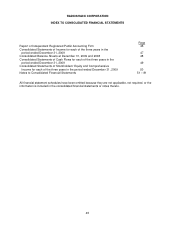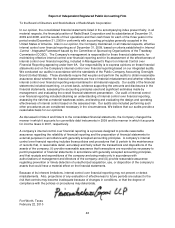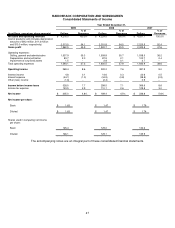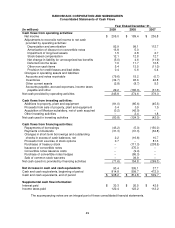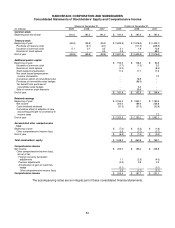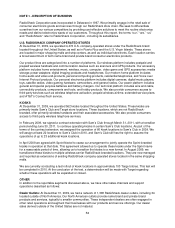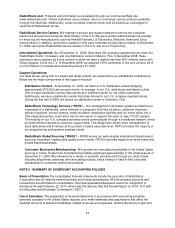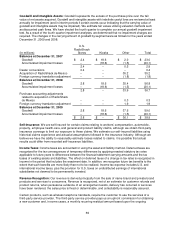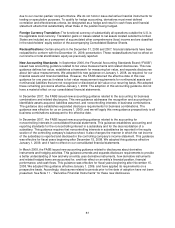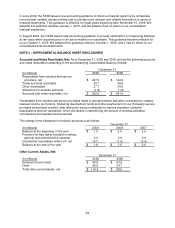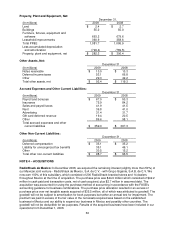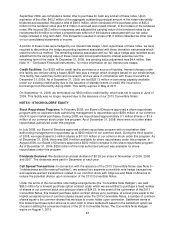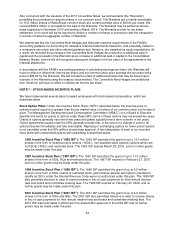Radio Shack 2009 Annual Report Download - page 61
Download and view the complete annual report
Please find page 61 of the 2009 Radio Shack annual report below. You can navigate through the pages in the report by either clicking on the pages listed below, or by using the keyword search tool below to find specific information within the annual report.54
loss contingencies at the date of the financial statements and during the periods presented. We base these
estimates on historical results and various other assumptions believed to be reasonable, all of which form
the basis for making estimates concerning the carrying values of assets and liabilities that are not readily
available from other sources. Actual results could differ materially from those estimates.
Cash and Cash Equivalents: Cash on hand in stores, deposits in banks and all highly liquid investments
with a maturity of three months or less at the time of purchase are considered cash and cash equivalents.
We carry our cash equivalents at cost, which approximates fair value because of the short maturity of the
instruments. The weighted average interest rates were 0.3% and 1.0% at December 31, 2009 and 2008,
respectively, for cash equivalents totaling $820.5 million and $747.8 million, respectively. We maintain zero
balance cash disbursement accounts with certain banks. Outstanding checks in excess of deposits with
these banks are classified as short-term debt in the Consolidated Balance Sheets. Changes in these
overdrafts from period to period are reported in the Consolidated Statements of Cash Flows as a financing
activity.
Accounts Receivable and Allowance for Doubtful Accounts: Concentrations of credit risk with respect
to customer and dealer receivables are limited due to the large number of customers, dealers and their
location in many different geographic areas of the country. We establish an allowance for doubtful accounts
based on factors surrounding the credit risk of specific customers, historical trends and other information.
Historically, such losses, in the aggregate, have not exceeded our expectations. Account balances are
charged against the allowance when we believe it is probable that the receivable will not be recovered. We
have concentration of credit risk from service providers in the wireless telephone industry, primarily Sprint
Nextel, AT&T and T-Mobile.
Inventories: Our inventories are stated at the lower of cost (principally based on average cost, which
approximates FIFO) or market value and are comprised primarily of finished goods. Included in the cost of
the inventories are in-bound freight expenses to our distribution centers, out-bound freight expenses to
our retail outlets, and other direct costs relating to merchandise acquisition and distribution. If the
calculated net realizable value of the inventory is determined to be less than the recorded cost, a
provision is made to reduce the carrying amount of the inventory.
Property, Plant and Equipment: We state our property, plant and equipment at cost, less accumulated
depreciation and amortization. Depreciation and amortization are calculated using the straight-line method
over the following useful lives: 10-40 years for buildings; 2-15 years for furniture, fixtures, equipment and
software; leasehold improvements are amortized over the shorter of the terms of the underlying leases,
including certain renewal periods, or the estimated useful lives of the improvements. Major additions and
betterments that substantially extend the useful life of an asset are capitalized and depreciated.
Expenditures for normal maintenance and repairs are charged directly to expense as incurred.
Capitalized Software Costs: We capitalize qualifying costs related to the acquisition or development of
internal-use software. Capitalization of costs begins after the conceptual formulation stage has been
completed. Capitalized costs are amortized over the estimated useful life of the software, which ranges
between three and five years. Capitalized software costs at December 31, 2009, 2008 and 2007, totaled
$46.6 million, $50.3 million and $50.4 million, net of accumulated amortization of $132.2 million, $124.2
million and $100.1 million, respectively.
Impairment of Long-Lived Assets: We review long-lived assets (primarily property, plant and equipment)
held and used, or to be disposed of, for impairment whenever events or changes in circumstances indicate
that the net book value of the asset may not be recoverable. Recoverability is assessed based on estimated
undiscounted cash flows from the useful asset. If the carrying amount of an asset is not recoverable, we
recognize an impairment loss equal to the amount by which the carrying amount exceeds fair value. We
estimate fair value based on projected future discounted cash flows. Our policy is to evaluate long-lived
assets for impairment at a store level for retail operations.
Leases: For lease agreements that provide for escalating rent payments or free-rent occupancy periods,
we recognize rent expense on a straight-line basis over the non-cancelable lease term and certain option
renewal periods that appear to be reasonably assured at the inception of the lease term. The lease term
commences on the date we take possession of or control the physical use of the property. Deferred rent
is included in other current liabilities in the Consolidated Balance Sheets.



